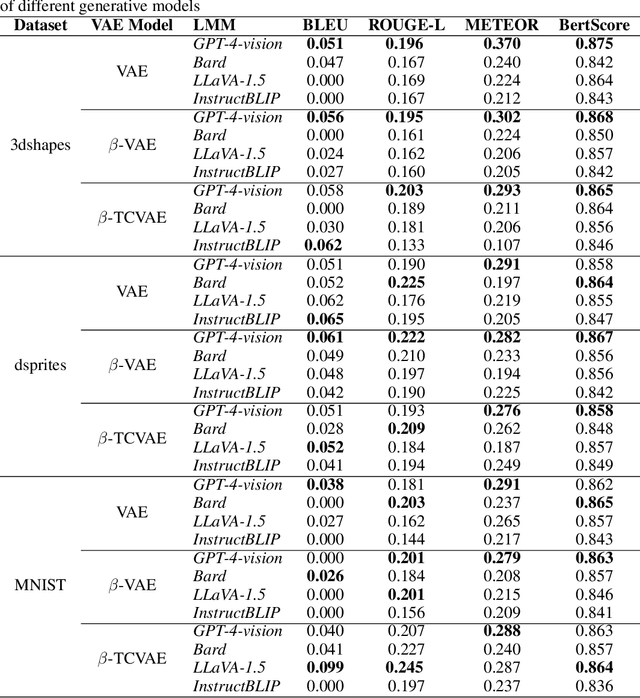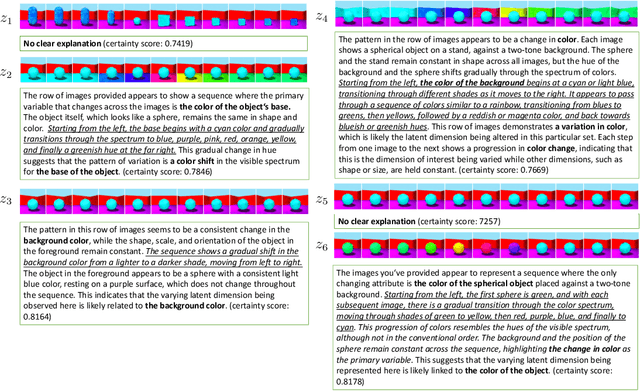Zhenke Liu
Explaining latent representations of generative models with large multimodal models
Feb 02, 2024



Abstract:Learning interpretable representations of data generative latent factors is an important topic for the development of artificial intelligence. With the rise of the large multimodal model, it can align images with text to generate answers. In this work, we propose a framework to comprehensively explain each latent factor in the generative models using a large multimodal model. We further measure the uncertainty of our generated explanations, quantitatively evaluate the performance of explanation generation among multiple large multimodal models, and qualitatively visualize the variations of each latent factor to learn the disentanglement effects of different generative models on explanations. Finally, we discuss the explanatory capabilities and limitations of state-of-the-art large multimodal models.
SurroCBM: Concept Bottleneck Surrogate Models for Generative Post-hoc Explanation
Oct 11, 2023Abstract:Explainable AI seeks to bring light to the decision-making processes of black-box models. Traditional saliency-based methods, while highlighting influential data segments, often lack semantic understanding. Recent advancements, such as Concept Activation Vectors (CAVs) and Concept Bottleneck Models (CBMs), offer concept-based explanations but necessitate human-defined concepts. However, human-annotated concepts are expensive to attain. This paper introduces the Concept Bottleneck Surrogate Models (SurroCBM), a novel framework that aims to explain the black-box models with automatically discovered concepts. SurroCBM identifies shared and unique concepts across various black-box models and employs an explainable surrogate model for post-hoc explanations. An effective training strategy using self-generated data is proposed to enhance explanation quality continuously. Through extensive experiments, we demonstrate the efficacy of SurroCBM in concept discovery and explanation, underscoring its potential in advancing the field of explainable AI.
Large Language Models for Spatial Trajectory Patterns Mining
Oct 07, 2023


Abstract:Identifying anomalous human spatial trajectory patterns can indicate dynamic changes in mobility behavior with applications in domains like infectious disease monitoring and elderly care. Recent advancements in large language models (LLMs) have demonstrated their ability to reason in a manner akin to humans. This presents significant potential for analyzing temporal patterns in human mobility. In this paper, we conduct empirical studies to assess the capabilities of leading LLMs like GPT-4 and Claude-2 in detecting anomalous behaviors from mobility data, by comparing to specialized methods. Our key findings demonstrate that LLMs can attain reasonable anomaly detection performance even without any specific cues. In addition, providing contextual clues about potential irregularities could further enhances their prediction efficacy. Moreover, LLMs can provide reasonable explanations for their judgments, thereby improving transparency. Our work provides insights on the strengths and limitations of LLMs for human spatial trajectory analysis.
Graph Neural Network for spatiotemporal data: methods and applications
May 30, 2023Abstract:In the era of big data, there has been a surge in the availability of data containing rich spatial and temporal information, offering valuable insights into dynamic systems and processes for applications such as weather forecasting, natural disaster management, intelligent transport systems, and precision agriculture. Graph neural networks (GNNs) have emerged as a powerful tool for modeling and understanding data with dependencies to each other such as spatial and temporal dependencies. There is a large amount of existing work that focuses on addressing the complex spatial and temporal dependencies in spatiotemporal data using GNNs. However, the strong interdisciplinary nature of spatiotemporal data has created numerous GNNs variants specifically designed for distinct application domains. Although the techniques are generally applicable across various domains, cross-referencing these methods remains essential yet challenging due to the absence of a comprehensive literature review on GNNs for spatiotemporal data. This article aims to provide a systematic and comprehensive overview of the technologies and applications of GNNs in the spatiotemporal domain. First, the ways of constructing graphs from spatiotemporal data are summarized to help domain experts understand how to generate graphs from various types of spatiotemporal data. Then, a systematic categorization and summary of existing spatiotemporal GNNs are presented to enable domain experts to identify suitable techniques and to support model developers in advancing their research. Moreover, a comprehensive overview of significant applications in the spatiotemporal domain is offered to introduce a broader range of applications to model developers and domain experts, assisting them in exploring potential research topics and enhancing the impact of their work. Finally, open challenges and future directions are discussed.
 Add to Chrome
Add to Chrome Add to Firefox
Add to Firefox Add to Edge
Add to Edge